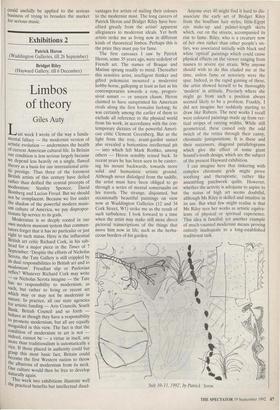Exhibitions 2
Patrick Heron
(Waddington Galleries, till 26 September)
Bridget Riley (Hayward Gallery, till 6 December)
Limbos of theory
Giles Auty
Last week I wrote of the way a funda- mental fallacy — the modernist version of artistic evolution — undermines the health of current American cultural life. In Britain our condition is less serious largely because we depend less heavily on a single, flawed theory as a basis for our international artis- tic prestige. Thus three of the foremost British artists of this century have defied rather than deified the central precepts of modernism: Stanley Spencer, David Bomberg and Lucian Freud. But we should not be complacent. Because we live under the shadow of the powerful modern muse- um culture of America, we pay dispropor- tionate lip service to its gods. Modernism is so deeply rooted in our own modern museum system that commen- tators forget that it has no particular or just right to such status. Here is the influential British art critic Richard Cork, in his sub- head for a major piece in the Times of 7 September: 'Despite the efforts of Nicholas S. erota, the Tate Gallery is still crippled by its dual responsibilities to British art and to modernism'. Freudian slip or Pavlovian reflex? Whatever Richard Cork may write or Nicholas Serota imagine — the Tate has no responsibility to modernism, as such, but rather to living or recent art which may or may not be modernist in nature. In practice, all our state agencies for artistic funding — Arts Councils, South Bank, British Council and so forth behave as though they have a responsibility to promote modernism, but all are equally misguided in this view. The fact is that the condition of modernism in art is not indeed, cannot be — a virtue in itself, any more than traditionalism is automatically a vice. If those placed in authority could but grasp this most basic fact, Britain could become the first Western nation to throw the albatross of modernism from its neck. Our culture would then be free to develop naturally again. This week two exhibitions illustrate well the practical benefits but intellectual disad-
vantages for artists of nailing their colours to the modernist mast. The long careers of Patrick Heron and Bridget Riley have ben- efited greatly from the artists' apparent allegiances to modernist ideals. Yet both artists strike me as living now in different kinds of theoretical limbos. Perhaps this is the price they must pay for fame.
The first canvases I saw by Patrick Heron, some 35 years ago, were redolent of French art. The names of Braque and Matisse sprang readily to mind. Thereafter this sensitive artist, intelligent thinker and gifted polemicist mounted a modernist hobby-horse, galloping at least as fast as his contemporaries towards a rosy, progres- sivist sunset — or unseen chasm. Heron claimed to have outsprinted his American rivals along the first formalist furlong; he was certainly among the earlier of them to exclude all reference to the physical world from his work, in accordance with the con- temporary dictates of the powerful Ameri- can critic Clement Greenberg. But as the light from the rosy, avant-gardist sunset also revealed a bottomless intellectual pit — into which fell Mark Rothko, among others — Heron sensibly reined back. In recent years he has been seen to be canter- ing his mount backwards, towards more solid and humanistic artistic ground. Although never dislodged from the saddle, the artist must have been obliged to go through a series of mental somersaults on his travels. The strange, disjointed, but occasionally beautiful paintings on view now at Waddington Galleries (12 and 34 Cork Street, W1) strike me as the result of such turbulence. I look forward to a time when the artist may make still more direct pictorial transcriptions of the things that move him now in life, such as the herba- ceous borders of his garden. Anyone over 40 might find it hard to dis- associate the early art of Bridget Riley from the bouffant hair styles, little-Egypt eye make-up and pelmet-length skirts which, out on the streets, accompanied its rise to fame. Riley, who is a creature now of her own rather than other people's six- ties, was associated initially with black and white 'optical' paintings which could cause physical effects on the viewer ranging from nausea to severe eye strain. Why anyone should wish to do this eluded me at the time, unless fame or notoriety were the spur. Indeed, in the rapid gaining of these, the artist showed herself to be thoroughly `modern' in attitude. Precisely where she might go from such a position always seemed likely to be a problem. Frankly, I did not imagine her suddenly starting to draw like Rubens. The next works I recall were coloured paintings made up from ver- tical stripes of varying widths. While still geometrical, these caused only the odd twitch of the retina through their canny, chromatic juxtapositions. It is these and their successors, diagonal parallelograms which give the effect of some giant hound's-tooth design, which are the subject of the present Hayward exhibition.
I can imagine here that tinkering with complex chromatic grids might prove soothing and therapeutic, rather like assembling patchwork quilts. However, whether the activity is adequate to aspire to the status of high art seems doubtful, although Ms Riley is skilled and intuitive in its use. But what few might realise is that Ms Riley sees her works as artistic equiva- lents of physical or spiritual experience. This idea is fanciful: yet another example of much-vaunted modernist means proving entirely inadequate to a long-established traditional task.
July 10-11, 1992', by Patrick 'leron


























































 Previous page
Previous page